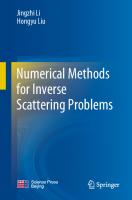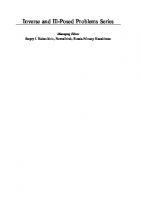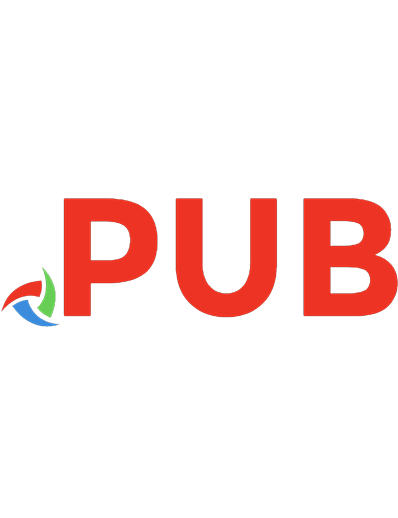Computational Methods for Applied Inverse Problems 9783110259056, 9783110259049
Nowadays inverse problems and applications in science and engineering represent an extremely active research field. The
166 99 12MB
English Pages 550 [552] Year 2012
Table of contents :
Preface
Editor’s Preface
I Introduction
1 Inverse Problems of Mathematical Physics
1.1 Introduction
1.2 Examples of Inverse and Ill-posed Problems
1.3 Well-posed and Ill-posed Problems
1.4 The Tikhonov Theorem
1.5 The Ivanov Theorem: Quasi-solution
1.6 The Lavrentiev’s Method
1.7 The Tikhonov Regularization Method
References
II Recent Advances in Regularization Theory and Methods
2 Using Parallel Computing for Solving Multidimensional Ill-posed Problems
2.1 Introduction
2.2 Using Parallel Computing
2.2.1 Main idea of parallel computing
2.2.2 Parallel computing limitations
2.3 Parallelization of Multidimensional Ill-posed Problem
2.3.1 Formulation of the problem and method of solution
2.3.2 Finite-difference approximation of the functional and its gradient
2.3.3 Parallelization of the minimization problem
2.4 Some Examples of Calculations
2.5 Conclusions
References
3 Regularization of Fredholm Integral Equations of the First Kind using Nyström Approximation
3.1 Introduction
3.2 Nyström Method for Regularized Equations
3.2.1 Nyström approximation of integral operators
3.2.2 Approximation of regularized equation
3.2.3 Solvability of approximate regularized equation
3.2.4 Method of numerical solution
3.3 Error Estimates
3.3.1 Some preparatory results
3.3.2 Error estimate with respect to || · ||2
3.3.3 Error estimate with respect to || · ||∞
3.3.4 A modified method
3.4 Conclusion
References
4 Regularization of Numerical Differentiation: Methods and Applications
4.1 Introduction
4.2 Regularizing Schemes
4.2.1 Basic settings
4.2.2 Regularized difference method (RDM)
4.2.3 Smoother-Based regularization (SBR)
4.2.4 Mollifier regularization method (MRM)
4.2.5 Tikhonov’s variational regularization (TiVR)
4.2.6 Lavrentiev regularization method (LRM)
4.2.7 Discrete regularization method (DRM)
4.2.8 Semi-Discrete Tikhonov regularization (SDTR)
4.2.9 Total variation regularization (TVR)
4.3 Numerical Comparisons
4.4 Applied Examples
4.4.1 Simple applied problems
4.4.2 The inverse heat conduct problems (IHCP)
4.4.3 The parameter estimation in new product diffusion model
4.4.4 Parameter identification of sturm-liouville operator
4.4.5 The numerical inversion of Abel transform
4.4.6 The linear viscoelastic stress analysis
4.5 Discussion and Conclusion
References
5 Numerical Analytic Continuation and Regularization
5.1 Introduction
5.2 Description of the Problems in Strip Domain and Some Assumptions
5.2.1 Description of the problems
5.2.2 Some assumptions
5.2.3 The ill-posedness analysis for the Problems 5.2.1 and 5.2.2
5.2.4 The basic idea of the regularization for Problems 5.2.1 and 5.2.2
5.3 Some Regularization Methods
5.3.1 Some methods for solving Problem 5.2.1
5.3.2 Some methods for solving Problem 5.2.2
5.4 Numerical Tests
References
6 An Optimal Perturbation Regularization Algorithm for Function Reconstruction and Its Applications
6.1 Introduction
6.2 The Optimal Perturbation Regularization Algorithm
6.3 Numerical Simulations
6.3.1 Inversion of time-dependent reaction coefficient
6.3.2 Inversion of space-dependent reaction coefficient
6.3.3 Inversion of state-dependent source term
6.3.4 Inversion of space-dependent diffusion coefficient
6.4 Applications
6.4.1 Determining magnitude of pollution source
6.4.2 Data reconstruction in an undisturbed soil-column experiment
6.5 Conclusions
References
7 Filtering and Inverse Problems Solving
7.1 Introduction
7.2 SLAE Compatibility
7.3 Conditionality
7.4 Pseudosolutions
7.5 Singular Value Decomposition
7.6 Geometry of Pseudosolution
7.7 Inverse Problems for the Discrete Models of Observations
7.8 The Model in Spectral Domain
7.9 Regularization of Ill-posed Systems
7.10 General Remarks, the Dilemma of Bias and Dispersion
7.11 Models, Based on the Integral Equations
7.12 Panteleev Corrective Filtering
7.13 Philips-Tikhonov Regularization
References
III Optimal Inverse Design and Optimization Methods
8 Inverse Design of Alloys’ Chemistry for Specified Thermo-Mechanical Properties by using Multi-objective Optimization
8.1 Introduction
8.2 Multi-Objective Constrained Optimization and Response Surfaces
8.3 Summary of IOSO Algorithm
8.4 Mathematical Formulations of Objectives and Constraints
8.5 Determining Names of Alloying Elements and Their Concentrations for Specified Properties of Alloys
8.6 Inverse Design of Bulk Metallic Glasses
8.7 Open Problems
8.8 Conclusions
References
9 Two Approaches to Reduce the Parameter Identification Errors
9.1 Introduction
9.2 The Optimal Sensor Placement Design
9.2.1 The well-posedness analysis of the parameter identification procedure
9.2.2 The algorithm for optimal sensor placement design
9.2.3 The integrated optimal sensor placement and parameter identification algorithm
9.2.4 Examples
9.3 The Regularization Method with the Adaptive Updating of A-priori Information
9.3.1 Modified extended Bayesian method for parameter identification
9.3.2 The well-posedness analysis of modified extended Bayesian method
9.3.3 Examples
9.4 Conclusion
References
10 A General Convergence Result for the BFGS Method
10.1 Introduction
10.2 The BFGS Algorithm
10.3 A General Convergence Result for the BFGS Algorithm
10.4 Conclusion and Discussions
References
IV Recent Advances in Inverse Scattering
11 Uniqueness Results for Inverse Scattering Problems
11.1 Introduction
11.2 Uniqueness for Inhomogeneity n
11.3 Uniqueness for Smooth Obstacles
11.4 Uniqueness for Polygon or Polyhedra
11.5 Uniqueness for Balls or Discs
11.6 Uniqueness for Surfaces or Curves
11.7 Uniqueness Results in a Layered Medium
11.8 Open Problems
References
12 Shape Reconstruction of Inverse Medium Scattering for the Helmholtz Equation
12.1 Introduction
12.2 Analysis of the scattering map
12.3 Inverse medium scattering
12.3.1 Shape reconstruction
12.3.2 Born approximation
12.3.3 Recursive linearization
12.4 Numerical experiments
12.5 Concluding remarks
References
V Inverse Vibration, Data Processing and Imaging
13 Numerical Aspects of the Calculation of Molecular Force Fields from Experimental Data
13.1 Introduction
13.2 Molecular Force Field Models
13.3 Formulation of Inverse Vibration Problem
13.4 Constraints on the Values of Force Constants Based on Quantum Mechanical Calculations
13.5 Generalized Inverse Structural Problem
13.6 Computer Implementation
13.7 Applications
References
14 Some Mathematical Problems in Biomedical Imaging
14.1 Introduction
14.2 Mathematical Models
14.2.1 Forward problem
14.2.2 Inverse problem
14.3 Harmonic Bz Algorithm
14.3.1 Algorithm description
14.3.2 Convergence analysis
14.3.3 The stable computation of ΔΒΖ
14.4 Integral Equations Method
14.4.1 Algorithm description
14.4.2 Regularization and discretization
14.5 Numerical Experiments
References
VI Numerical Inversion in Geosciences
15 Numerical Methods for Solving Inverse Hyperbolic Problems
15.1 Introduction
15.2 Gel’fand-Levitan-Krein Method
15.2.1 The two-dimensional analogy of Gel'fand-Levitan-Krein equation
15.2.2 N-approximation of Gel'fand-Levitan-Krein equation
15.2.3 Numerical results and remarks
15.3 Linearized Multidimensional Inverse Problem for the Wave Equation
15.3.1 Problem formulation
15.3.2 Linearization
15.4 Modified Landweber Iteration
15.4.1 Statement of the problem
15.4.2 Landweber iteration
15.4.3 Modification of algorithm
15.4.4 Numerical results
References
16 Inversion Studies in Seismic Oceanography
16.1 Introduction of Seismic Oceanography
16.2 Thermohaline Structure Inversion
16.2.1 Inversion method for temperature and salinity
16.2.2 Inversion experiment of synthetic seismic data
16.2.3 Inversion experiment of GO data (Huang et al., 2011)
16.3 Discussion and Conclusion
References
17 Image Resolution Beyond the Classical Limit
17.1 Introduction
17.2 Aperture and Resolution Functions
17.3 Deconvolution Approach to Improved Resolution
17.4 MUSIC Pseudo-Spectrum Approach to Improved Resolution
17.5 Concluding Remarks
References
18 Seismic Migration and Inversion
18.1 Introduction
18.2 Migration Methods: A Brief Review
18.2.1 Kirchhoff migration
18.2.2 Wave field extrapolation
18.2.3 Finite difference migration in ω — X domain
18.2.4 Phase shift migration
18.2.5 Stolt migration
18.2.6 Reverse time migration
18.2.7 Gaussian beam migration
18.2.8 Interferometric migration
18.2.9 Ray tracing
18.3 Seismic Migration and Inversion
18.3.1 The forward model
18.3.2 Migration deconvolution
18.3.3 Regularization model
18.3.4 Solving methods based on optimization
18.3.5 Preconditioning
18.3.6 Preconditioners
18.4 Illustrative Examples
18.4.1 Regularized migration inversion for point diffraction scatterers
18.4.2 Comparison with the interferometric migration
18.5 Conclusion
References
19 Seismic Wavefields Interpolation Based on Sparse Regularization and Compressive Sensing
19.1 Introduction
19.2 Sparse Transforms
19.2.1 Fourier, wavelet, Radon and ridgelet transforms
19.2.2 The curvelet transform
19.3 Sparse Regularizing Modeling
19.3.1 Minimization in l0 space
19.3.2 Minimization in l1 space
19.3.3 Minimization in lp-lq space
19.4 Brief Review of Previous Methods in Mathematics
19.5 Sparse Optimization Methods
19.5.1 lo quasi-norm approximation method
19.5.2 l1-norm approximation method
19.5.3 Linear programming method
19.5.4 Alternating direction method
19.5.5 l1-norm constrained trust region method
19.6 Sampling
19.7 Numerical Experiments
19.7.1 Reconstruction of shot gathers
19.7.2 Field data
19.8 Conclusion
References
20 Some Researches on Quantitative Remote Sensing Inversion
20.1 Introduction
20.2 Models
20.3 A Priori Knowledge
20.4 Optimization Algorithms
20.5 Multi-stage Inversion Strategy
20.6 Conclusion
References
Index



![Computational Methods for Inverse Problems in Imaging [1st ed. 2019]
978-3-030-32881-8, 978-3-030-32882-5](https://dokumen.pub/img/200x200/computational-methods-for-inverse-problems-in-imaging-1st-ed-2019-978-3-030-32881-8-978-3-030-32882-5.jpg)
![Investigation Methods for Inverse Problems [Reprint 2014 ed.]
9783110943849, 9783110364194](https://dokumen.pub/img/200x200/investigation-methods-for-inverse-problems-reprint-2014nbsped-9783110943849-9783110364194.jpg)





